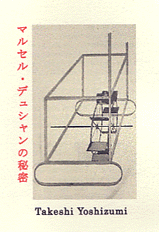ZUIHUUKAN
▶TOP PAGE
The Secret of DUCHAMP

Bibliography
DUCHAMP CODE
The Secret of Marcel Duchamp's works
This paper attempts to prove that Marcel Duchamp’s works are significantly influenced by, and actually based on the Taoism (Daoism). The notion of Taoism refers not only to the religion but also to the philosophy of the Lao-tzu (Laozu) and the Chuang-tzu (Zhuangzi).
Arturo Schwarz argues in his book, The Complete Works of Marcel Duchamp (2000), that Young Man and Girl in Spring (1911) is a turning point of Duchamp’s works. Noting that the basic theme of this painting is a metaphor for the struggle to produce the Philosopher’s Stone, he suggests that Duchamp’s works after the turning point might be owing to the alchemy.
Although Taoism traditions contributed to the development of the alchemy, the basic principles of the alchemy in China are based on the Book of Change (I Ching) which is the most renown work among the Chinese classics. I will proceed with my argument that Duchamp owed the concept of Nude Descending a Staircase , NO.2 (1912) to the Book of Change( I Ching ).
I will then point out the parallels between The Bride Stripped Bare By Her Bachelors, Even (or The Large Glass, 1915-23) and the “nei-jing-tu,” an illustration of the “nei-dan” in the Chinese alchemy. Consequently, based on these observations, I will point out that The Large Glass might in fact be based upon the “nai-jing-tu”.
Furthermore, I will discuss the relation between the concepts of Duchamp’s works called as ‘readymade’ and the philosophy of the Lao-tzu, and the relation between the concept of Tu m'(1918) and the philosophy of the Chuang-tzu.
.....
from Takeshi YOSHIZUMI, The Secret of Marcel Duchamp's works, (2004)
⇒ New Version 2008